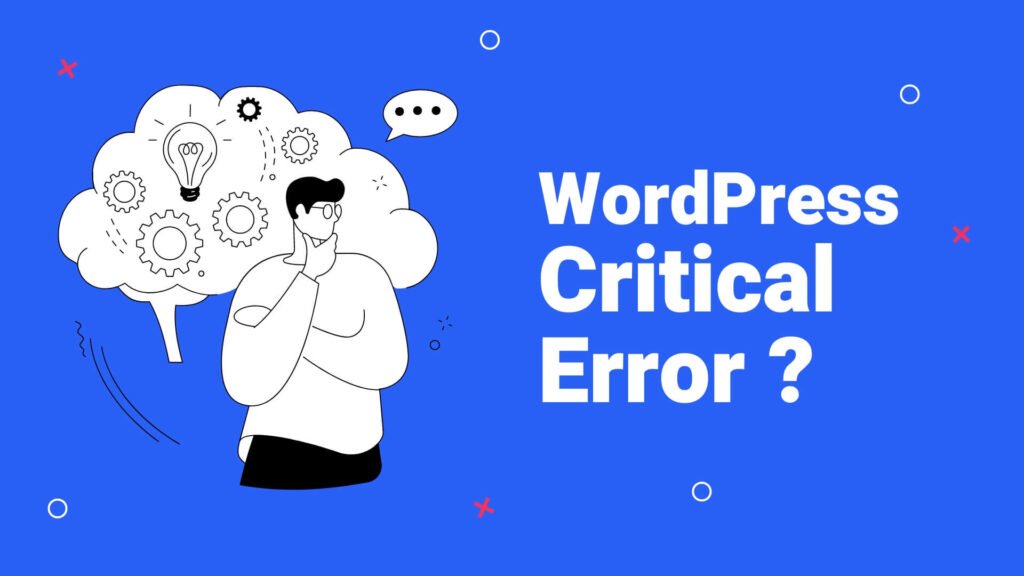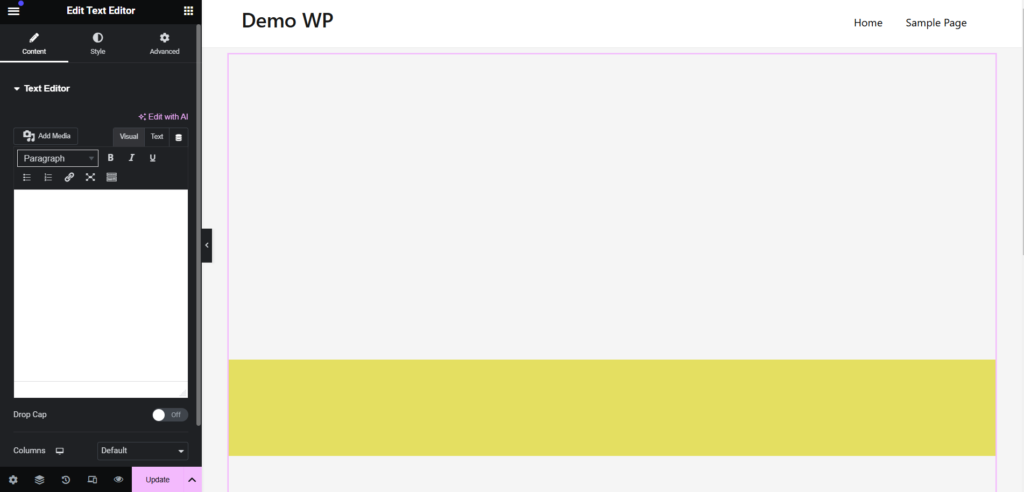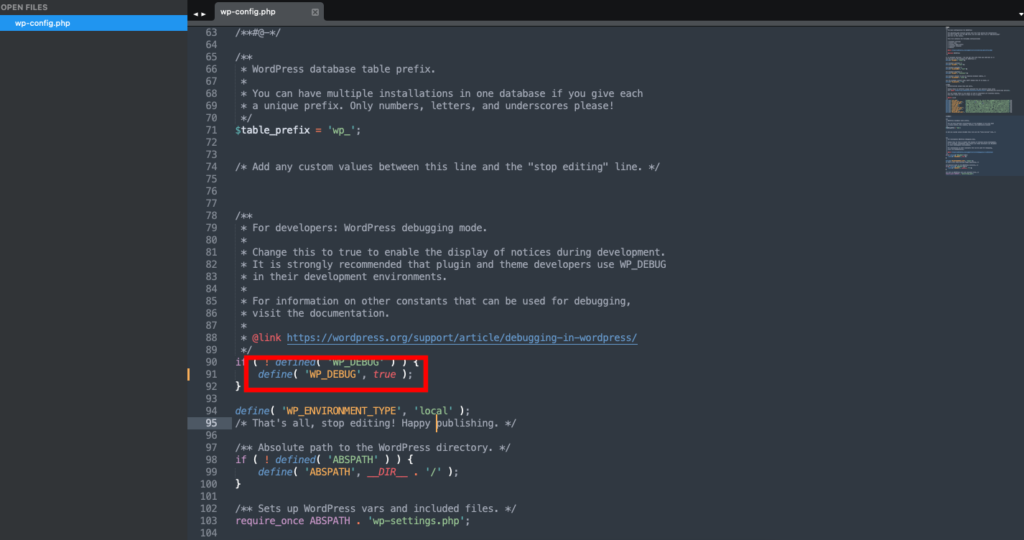What is a WordPress Critical Error?
A WordPress critical error is a serious issue that can bring your website to a halt, leaving you with a daunting white screen of death or an error message that signals your site’s temporary unavailability. These occurrences are alarming, but delving into their origins and learning how to tackle them head-on can empower you to navigate these challenges with confidence.

These errors often stem from conflicting plugins or themes, PHP script issues, or insufficient memory limits on your hosting server. For effective troubleshooting it is crucial to identify the specific cause. Once pinpointed, solutions range from deactivating problematic plugins or themes to adjusting PHP settings or memory allocation.
By proactively monitoring your site’s performance, keeping plugins and themes updated, and implementing robust backup solutions, you can mitigate the risk of encountering critical errors. Being prepared with a step-by-step response plan ensures that if an error does arise, you’re equipped to swiftly restore functionality and minimize disruption to your site’s operations.
Why Do They Happen?
1. Resource Limitations:
WordPress sites require a certain amount of server resources, such as memory and CPU. If your site exceeds these limits, it can trigger a WordPress critical error. This often happens when there are too many plugins or when the website experiences a sudden spike in traffic.
2. Code Errors:
Errors in your website’s code, such as incompatible themes or plugins, can cause a WordPress critical error. Updates to WordPress, themes, or plugins can sometimes introduce conflicts that lead to these issues.
3. Malware:
Malicious software can infiltrate your WordPress site, leading to various problems, including a WordPress critical error. Malware can corrupt your site’s files or database, making it difficult for the website to load correctly.
4. Database Issues:
WordPress relies heavily on its database for storing content, settings, and other essential data. Issues with the database can lead to critical errors:
- Database Corruption: Corruption can occur due to hardware failures, improper shutdowns, or software bugs, resulting in data inconsistencies.
- Database Size: Large databases without proper optimization can slow down queries, leading to timeouts or errors.
5. Server Configuration Problems:
The server hosting your WordPress site plays a crucial role in its performance and stability:
- PHP Configuration: Incorrect PHP settings or outdated PHP versions can cause compatibility issues with WordPress and its plugins.
- Server Load: High server load due to excessive traffic or inefficient resource allocation can trigger timeouts or 503 errors.
6. File Permissions and Ownership:
Incorrect file permissions or ownership settings on your server can prevent WordPress from accessing necessary files:
- Permission Issues: Improper file permissions can restrict WordPress from writing to certain directories or executing scripts.
- Ownership Problems: Files owned by the wrong user or group can lead to permission denied errors during site operations.
7. DNS and Domain Configuration:
Issues related to domain settings or DNS configuration can affect site accessibility:
- DNS Propagation: Changes to DNS records may take time to propagate globally, causing temporary site unavailability.
- Domain Renewal: Expired domains or misconfigured DNS settings can lead to domain-related errors.
8. External Services and Integrations:
WordPress sites often integrate with third-party services or APIs, which can introduce dependencies and potential issues:
- API Changes: Updates or changes to third-party APIs can break integrations, causing errors or unexpected behavior.
- Service Outages: Unavailable or overloaded external services can impact site functionality reliant on those services.
9. User Error:
Mistakes made during site updates, configuration changes, or content management can lead to critical errors:
- Configuration Mistakes: Incorrect settings or changes made without proper testing can disrupt site functionality.
- Content Management Errors: Deleting essential files, database entries, or mismanaging content can render the site unusable.
The Importance of Staying Calm and Troubleshooting

Experiencing a WordPress critical error can be stressful, especially if it leads to website downtime. However, staying calm and following a systematic troubleshooting process is crucial. Here’s why:
- Minimize Downtime: A clear-headed approach can help you quickly identify and fix the WordPress critical error, reducing the amount of time your site is offline.
- Prevent Further Issues: Panicking and making hasty changes can lead to additional problems. A calm, methodical approach ensures that you don’t inadvertently create new issues while addressing the WordPress critical error.
- Learning Opportunity: Troubleshooting a WordPress critical error can be a valuable learning experience. Understanding the root cause of the error can help you prevent similar issues in the future and improve your overall WordPress management skills.
A WordPress critical error can be daunting, but it is often fixable with a bit of patience and troubleshooting. By understanding the common causes of a WordPress critical error and maintaining a calm approach, you can effectively manage these errors and keep your website running smoothly.
Facing the White Screen: Initial Steps
Encountering a WordPress critical error and the accompanying white screen can be daunting. However, by taking immediate and careful steps, you can begin to troubleshoot and resolve the issue effectively. Here’s a more detailed guide on what to do initially:

1. Don’t Refresh!
When you first see the white screen, resist the urge to repeatedly refresh the page. This can be challenging, especially if your site is live and you’re feeling the pressure to get it back online quickly. However, the initial error message displayed might hold valuable clues about the nature of the WordPress critical error. Look for specific error codes or messages that can help pinpoint the problem. These messages can sometimes indicate the file or plugin causing the issue, which is crucial information for your troubleshooting efforts.
2. Check Your Admin Email
WordPress has a built-in feature that sends an email to the site administrator when a critical error occurs. This email often contains details about what caused the error and tips for fixing it. Check the email associated with your WordPress admin account for any messages from WordPress core. These emails can include the name of the plugin or theme causing the error, a description of the issue, and sometimes even a link to access the site in recovery mode, where you can safely deactivate the problematic plugin or theme without affecting the rest of your site.
3. Backup Your Website
Before attempting any fixes, it’s critical to create a backup of your website. If you have access to your site’s control panel or hosting account, use the backup tools provided to create a full backup of your site’s files and database. If your hosting provider offers automated backups, verify that a recent backup is available. Backing up your site ensures that you can restore it to its previous state if something goes wrong during the troubleshooting process. This step is particularly important because troubleshooting a WordPress critical error may involve deactivating plugins, switching themes, or even modifying code, any of which can potentially introduce new issues or further destabilize your site.
Creating a Backup Manually:
- Files: Use an FTP client to download all your website files from the server to your local computer. Make sure to download the entire WordPress directory, including the wp-content folder, which contains your themes, plugins, and uploads.
- Database: Access your hosting control panel (such as cPanel) and use phpMyAdmin to export your WordPress database. Ensure you select all tables and use the export function to create a SQL file of your database.
By following these initial steps, you can approach the situation methodically and increase your chances of resolving the WordPress critical error efficiently. Staying calm and organized during this process not only helps you fix the current issue but also prepares you for better handling similar problems in the future.
Common Causes & Troubleshooting Techniques
1. Plugin Conflicts:
Plugin conflicts occur when two or more plugins on your WordPress site interfere with each other’s functionality, leading to errors or unexpected behavior. Here are additional considerations:
- Detecting Conflicts: If deactivating plugins one-by-one doesn’t identify the conflict, consider:
- Plugin Pairs: Sometimes conflicts only arise when specific plugins are active together.
- Server Environment: Check if conflicts occur under specific server configurations or PHP versions.
- Preventative Measures: To minimize conflicts:
- Plugin Selection: Choose plugins from reputable sources and avoid using multiple plugins that perform similar functions.
- Regular Updates: Keep all plugins updated to the latest versions, as updates often include bug fixes and compatibility improvements.
Scenario: Plugin Conflict with Elementor and SiteOrigin Page Builder

You install both Elementor and SiteOrigin Page Builder to enhance your WordPress site. First, you create a page using SiteOrigin, carefully structuring and designing your content. Later, you attempt to edit the same page with Elementor, only to find the content unreadable or missing. This issue arises because the two page builders store and manage content differently, leading to compatibility conflicts. To avoid this, use a single page builder per page and always back up your site before making major changes.
2. Theme Issues:
Themes control the visual appearance and layout of your WordPress site. Here’s more on handling theme-related issues:
- Custom Theme Considerations: If using a custom theme:
- Child Themes: Implement changes via child themes to preserve customizations during theme updates.
- Theme Documentation: Refer to theme documentation for troubleshooting steps specific to your theme.
- Debugging Themes: When encountering issues with a theme:
- Inspect CSS and JavaScript: Use browser developer tools to identify conflicting styles or scripts.
- Theme Support: Contact the theme developer for assistance or check forums and support channels for similar issues and solutions.
3. Roll Back Your Site:
Rolling back changes can revert your WordPress site to a stable state before encountering issues. Further insights include:
- Backup Strategy: Regularly create and maintain backups of your WordPress site:
- Backup Plugins: Use plugins that offer automated backups with restore capabilities.
- Manual Backups: For critical updates, manually backup files and database before proceeding.
- Version Control: Utilize version control systems (e.g., Git) for managing changes:
- Commit Changes: Commit changes incrementally to track modifications and facilitate rollbacks if necessary.
4. Check or Upgrade for Supported Versions:
Using outdated software versions poses security risks and compatibility issues. Here’s more on ensuring your WordPress installation remains up-to-date:
- Version Compatibility: Check compatibility of themes and plugins with the latest WordPress version:
- Plugin and Theme Documentation: Review release notes for compatibility information.
- WordPress Core Updates: Regularly update WordPress core to benefit from security patches and new features.
- Staging Environment: Test updates in a staging environment before applying changes to production:
- Testing Procedures: Verify functionality and performance across different browsers and devices.
5. Resource Limitations:
Optimizing resources enhances site performance and user experience. Consider these additional strategies:
- Caching Mechanisms: Implement caching plugins to reduce server load and speed up content delivery:
- Cache Expiration: Configure cache expiration times to balance freshness with performance.
- Content Delivery Networks (CDNs): Distribute content across global servers to reduce latency:
- CDN Integration: Integrate CDNs with WordPress using plugins or through hosting provider options.
- Server Optimization: Consult with your hosting provider to optimize server settings:
- Performance Monitoring: Use monitoring tools to track server resource usage and identify bottlenecks.
6. Debugging Mode:
Enabling debugging mode provides detailed error messages that aid in troubleshooting complex issues. Here’s more on utilizing this feature effectively:

- Error Reporting: Configure error reporting settings in wp-config.php to display and log errors:
- Error Types: Monitor PHP errors, warnings, and notices to diagnose issues systematically.
- Debugging Tools: Utilize debugging plugins for enhanced diagnostics:
- Plugin Integration: Some plugins offer advanced debugging features and integrations with debugging tools.
7. Malware Infection:
Security breaches can compromise site integrity and visitor trust. Here are additional measures to safeguard your WordPress site:
- Security Audits: Conduct regular security audits using reputable security plugins:
- Vulnerability Scans: Scan for vulnerabilities in themes, plugins, and core files.
- User Permissions: Manage user permissions and restrict access to sensitive areas:
- Role-Based Access: Assign roles with appropriate permissions to minimize security risks.
- Backup and Recovery: Maintain off-site backups and disaster recovery plans:
- Backup Frequency: Schedule automated backups to ensure data integrity and recovery options.
By implementing these advanced troubleshooting and security measures, you can enhance the stability, performance, and security of your WordPress website effectively. Each approach aims to address specific challenges and ensure a robust online presence for your site visitors.
You may also want to look into these other WordPress errors, as you could be experiencing multiple of them:
- ERR_CONNECTION_TIMED_OUT — Caused by a slow or overloaded web server.
- ERR_CACHE_MISS — If you see this, look into your website’s cache or PHP tools like plugins, as they’re very likely the cause.
- 500 Internal Server Error — A serious error that can usually be traced back to server file corruption.
- Error Establishing a Database Connection — Corruption in your database or a database server issue can be the root of this problem.
- HTTP 503 Service Unavailable — Indicates an issue with your server.
- HTTP 502 Bad Gateway — Yet another server issue, often caused by too many visitors overloading it.
Still Stuck? Getting Help
If you’ve tried the common troubleshooting techniques and are still facing a WordPress critical error, it may be time to seek additional help. Here are some resources and steps you can take to get the support you need:
Resources for Further Troubleshooting
WordPress Support Forums:
- Accessing the Forums:
- Visit the WordPress Support Forums, a community-driven platform where you can ask questions and get help from other WordPress users and experts.
- Searching for Similar Issues:
- Use the search function to find threads related to your specific WordPress critical error. Many users have likely encountered similar issues, and you might find a solution that has worked for others.
- Posting Your Question:
- If you can’t find a solution, create a new topic in the appropriate forum category. Provide detailed information about your issue, including any error messages, recent changes to your site, and steps you’ve already taken to troubleshoot.
WordPress Documentation:
- Reviewing the Codex:
- The WordPress Codex contains extensive documentation on WordPress functions, features, and troubleshooting tips.
- Checking the Support Page:
- The WordPress Support Page offers guides and documentation on various topics, including how to fix common errors.
Reaching Out to Your Hosting Provider
Contacting Support:
- Using Support Channels:
- Most hosting providers offer multiple support channels, including live chat, email, and phone support. Contact your hosting provider through one of these channels to get assistance with your WordPress critical error.
- Providing Details:
- When contacting support, provide detailed information about your issue, including any error messages and steps you’ve taken to troubleshoot. This helps the support team diagnose and resolve the issue more quickly.
Hosting Provider Solutions:
- Server-Specific Issues:
- Your hosting provider might be aware of server-specific issues that could be causing the WordPress critical error. They can check server logs, increase server resources, or provide specific instructions to resolve the issue.
- Backup and Restore:
- Many hosting providers offer automated backups. If troubleshooting doesn’t work, your hosting provider may be able to restore your website to a previous state before the error occurred.
Hiring a WordPress Developer
Finding a Developer:
- Freelance Platforms:
- Platforms like Upwork, Fiverr, and Freelancer allow you to find experienced WordPress developers who can help resolve complex issues.
- WordPress Job Boards:
- The WordPress Job Board is a great place to find professionals who specialize in WordPress development and troubleshooting
- Contact Spiracle Themes:
- You can also contact us to hire WordPress developers. We have an excellent and knowledgeable team ready to fix your WordPress website.
Choosing the Right Developer:
- Check Credentials:
- Review the developer’s credentials, experience, and past projects. Look for developers with positive reviews and a proven track record of resolving WordPress issues.
- Detailed Job Description:
- When hiring a developer, provide a detailed description of your issue, including any error messages, troubleshooting steps you’ve taken, and the urgency of the situation. Clear communication ensures the developer understands the problem and can address it effectively.
By utilizing these resources and seeking professional help, you can effectively address a WordPress critical error and get your website back up and running.
Conclusion
Facing a WordPress critical error can be a stressful experience, but with the right approach and resources, you can resolve the issue and get your website back online. Let’s recap the steps to take when encountering a WordPress critical error:
Steps to Take When Facing a WordPress Critical Error
- Don’t Refresh!
- Read the error message carefully as it might provide clues about the issue.
- Check Your Admin Email
- Look for emails from WordPress with troubleshooting tips and information about the error.
- Backup Your Website
- Create a backup of your site’s files and database before attempting any fixes.
- Common Causes & Troubleshooting Techniques
- Plugin Conflicts: Deactivate all plugins and reactivate them one-by-one to identify the culprit. Update or reinstall problematic plugins.
- Theme Issues: Switch to a default theme to see if the error persists. Update your theme files.
- Resource Limitations: Increase your PHP memory limit and optimize images and code for faster loading times.
- Debugging Mode: Enable debugging mode in your wp-config.php file and analyze the debug log for specific error messages.
- Malware Infection: Scan your website for malware using a security plugin and consider professional help if malware is detected.
- Still Stuck? Getting Help
- Resources for Further Troubleshooting: Utilize WordPress support forums and documentation.
- Reaching Out to Your Hosting Provider: Contact your hosting provider for assistance and potential solutions.
- Hiring a WordPress Developer: Seek professional help for complex issues through freelance platforms and WordPress job boards.
Importance of Regular Backups and Website Maintenance
Regular backups and website maintenance are crucial for preventing and quickly resolving issues like a WordPress critical error. Here’s why:
- Regular Backups:
- Backups ensure that you can restore your website to a previous state if something goes wrong. Schedule automatic backups and keep multiple backup copies in different locations (e.g., cloud storage, local storage).
- Website Maintenance:
- Regular maintenance, such as updating WordPress core, themes, and plugins, can prevent many issues. Perform routine security scans, optimize your database, and monitor your site’s performance to keep it running smoothly.
Feeling Empowered to Tackle Website Issues!
Dealing with a WordPress critical error can be challenging, but with the knowledge and resources provided, you should feel empowered to tackle website issues confidently. By staying calm, following a systematic troubleshooting process, and seeking help when needed, you can effectively manage and resolve critical errors, ensuring your website remains a reliable and valuable asset.
Remember, proactive measures like regular backups and maintenance are your best defense against future problems. With these practices in place, you’ll be well-equipped to handle any issues that come your way.
Spiracle Themes: Your Partner in Managing WordPress Critical Errors

At Spiracle Themes, we understand that encountering a WordPress critical error can be overwhelming. Our team of experienced developers is here to help you navigate these challenges with ease. From troubleshooting plugin conflicts and theme issues to increasing PHP memory limits and conducting thorough malware scans, we’ve got you covered.
Whether you need guidance from the WordPress support forums, assistance from your hosting provider, or professional development services, Spiracle Themes will support you every step of the way. With our expertise and dedication, you can ensure your website remains secure, up-to-date, and running smoothly. Let us help you restore your site and give you peace of mind.
What is a WordPress Critical Error?
A WordPress critical error is a serious issue that prevents your website from functioning correctly. It can result in a blank screen, error messages, or site downtime, often caused by issues with themes, plugins, or code.
How can I fix a WordPress Critical Error?
To fix a WordPress critical error:
- Check Error Logs: Look for detailed error messages in your server’s error logs.
- Disable Plugins/Themes: Access your site via FTP or file manager and rename the plugins or themes folder to disable them. This helps identify if a plugin or theme is causing the issue.
- Increase PHP Memory Limit: Edit the
wp-config.phpfile and increase the memory limit by addingdefine('WP_MEMORY_LIMIT', '256M');. - Reinstall WordPress Core Files: Download the latest version of WordPress and replace the core files (excluding the wp-content folder and wp-config.php).
How can I enable debugging to identify the cause of the error?
To enable debugging:
- Edit
wp-config.phpand add or modify the following lines:
define('WP_DEBUG', true);
define('WP_DEBUG_LOG', true);
define('WP_DEBUG_DISPLAY', false);debug.log in the wp-content directory.What if the error persists after troubleshooting?
If the error persists, consider reaching out to your hosting provider for support. They may be able to help with server-related issues or restore a backup if needed.
Can a WordPress Critical Error affect my site’s SEO?
Yes, a critical error can affect your site’s SEO by making your site inaccessible to search engines and users. It’s important to resolve these issues promptly to minimize any negative impact on your search rankings.









